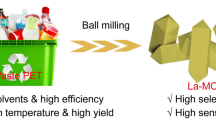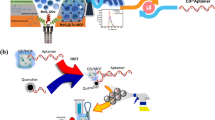Abstract
In the present study, an attempt was made to develop a proof of concept for the detection of nitroaromatic explosive derivatives through the photoluminescence (PL) quenching process using functionalized diatom frustules as a sensing platform. The diatom frustules are composed of nanostructured, highly porous biogenic silica material and emit strong, visible blue PL upon UV excitation. PL-active biosilica was isolated from the marine diatom Nitzschia sp. and was amine-functionalized to develop a sensing platform. Functionalized diatom frustules were further characterized using field emission scanning electron microscope and a series of spectroscopic methods. When nitroaromatic compounds were bound to the functionalized diatom frustules biosilica, the PL intensity from the functionalized biosilica was partially quenched due to the electrophilic nature of the nitro (–NO) groups. The quenching process confirmed the Meisenheimer complex formation and was investigated by using Fourier transform infrared spectroscopy and time-resolved photoluminescence studies. The developed platform was further evaluated for its sensitivity and specificity, and the limit of detection (LOD) of the assay was determined as 1 μM for a series of nitroaromatic explosive compounds. In conclusion, the developed sensing platform will have great utility in the development of on-site detection platforms for sensitive detection of warfare explosive nitroaromatic compounds from the environment.











Similar content being viewed by others
Reference
Agency for Toxic Substances and Disease Registry (ATSDR) (1995) Toxicological profile for 2,4,6-Trinitrotoluene (TNT). Atlanta, GA: U.S. Department of Health and Human Services, Public Health Service. https://www.atsdr.cdc.gov/toxprofiles/TP.asp?id=677&tid=125
APHA (2012) Standard methods for the examination of water and waste water, 22nd edn. American Public Health Association, Washington
Bappaditya G, Arun Kumar B, Partha Sarathi M (2014) Modification of extended open frameworks with fluorescent tags for sensing explosives: competition between size selectivity and electron deficiency. Chem Eur J 20(8):2276–2291. https://doi.org/10.1002/chem.201302455
Barbara S (2004) Infrared spectroscopy: fundamentals and application. Wiley, New York
Bismuto A, Setaro A, Maddalena P, De Stefano L, De Stefano M (2000) Marine diatoms as optical chemical sensors: a time-resolved study. Sensors Actuators B Chem 130(1):396–399. https://doi.org/10.1016/j.snb.2007.09.012
Bruno G, Le Costaouec T, Burel C, Lerouge P, Helbert W, Bardor M (2015) Diatom-specific oligosaccharide and polysaccharide structures help to unravel biosynthetic capabilities in diatoms. Mar Drugs 13(9):5993–6018. https://doi.org/10.3390/md13095993
Christen V, Fent K (2012) Silica nanoparticles and silver-doped silica nanoparticles induce endoplasmatic reticulum stress response and alter cytochrome P4501A activity. Chemosphere 87(4):423–434. https://doi.org/10.1016/j.chemosphere.2011.12.046
Crawford SA, Higgins MJ, Mulvaney P, Wetherbee R (2001) Nanostructure of the diatom frustule as revealed by atomic force and scanning electron microscopy. J Phycol 37(4):543–554. https://doi.org/10.1046/j.1529-8817.2001.037004543.x
De Stefano L, De Stefano M, Bismuto A, Maddalena P, Rendina I (2005) Marine diatoms as optical chemical sensors. Appl Phys Lett 87(23):233902 (1-3). https://doi.org/10.1063/1.2140087
De Stefano L, Lamberti A, Rotiroti L, De Stefano M (2008) Interfacing the nanostructured biosilica microshells of the marine diatom Coscinodiscus wailesii with biological matter. Acta Biomater 4(1):126–130. https://doi.org/10.1016/j.actbio.2007.09.003
Fengxiang W, Zhenyan G, Lei W, Wang W, Xia X, Hao Q (2014) Graphene quantum dots as a fluorescent sensing platform for highly efficient detection of copper (II) ions. Sensors Actuators B Chem 190:516–522. https://doi.org/10.1016/j.snb.2013.09.009
Gale DK, Gutu T, Jiao J, Chang CH, Rorrer GL (2009) Photoluminescence detection of biomolecules by antibody-functionalized diatom biosilica. Adv Funct Mater 19(6):926–933. https://doi.org/10.1002/adfm.200801137
Goswami B, Choudhury A, Buragohain AK (2012) Luminescence properties of a nanoporous freshwater diatom. Luminescence 27(1):16–19
Guillard RRL, Ryther JH (1962) Studies of marine planktonic diatoms. I. Cyclotella nana Hustedt, and Detonula confervacea (cleve) Gran. Can J Microbiol 8(2):229–239. https://doi.org/10.1139/m62-029
Hongbo Z, Shahbazi M-A, Ermei Mäkilä M, Tiago H, Silva Rui L, Reis JSJ, Jouni T, Hirvonen HSA (2013) Diatom silica microparticles for sustained release and permeation enhancement following oral delivery of prednisone and mesalamine. Biomaterials 34(36):9210–9219. https://doi.org/10.1016/j.biomaterials.2013.08.035
Hong-Xia Z, Cao A-M, Jin-Song H, Wan L-J, Lee S-T (2006) Electrochemical sensor for detecting ultratracenitroaromatic compounds using mesoporous SiO2-modified electrode. Anal Chem 78(6):1967–1971. https://doi.org/10.1021/ac051826s
Ilaria R, Terracciano M, Chandrasekaran S, Voelcker N, Dardano P, Martucci NM, Lamberti A, De Stefano L (2016) Bioengineered silicon diatoms: adding photonic features to a nanostructured semiconductive material for biomolecular sensing. Nanoscale Res Lett 11:405. https://doi.org/10.1186/s11671–016–1624-1
Jafar END, de la Miguel G (2011) Applications of diatoms and silica nanotechnology in biosensing, drug and gene delivery, and formation of complex metal nanostructures. Trends Anal Chem 30(9):1538–1548. https://doi.org/10.1016/j.trac.2011.04.015
Jayashree J, Pradhan N, Dash BP, Panda PK, Mishra BK (2015) Pigment mediated biogenic synthesis of silver nanoparticles using diatom Amphora sp. and its antimicrobial activity. J Saudi Chem Soc 19(6):661–666. https://doi.org/10.1016/j.jscs.2014.06.005
Jie L, Guangxue F, Rongrong L, Nikodem T, Lin M, Gagik GG, Bin L (2014) Quantum-dot-sized single-chain conjugated polyelectrolyte nanoparticles: synthesis, characterization and application for specific extracellular labeling and imaging. Small 10(15):3110–3118. https://doi.org/10.1002/smll.201303505
Johanna R, Berthold M, Guth U (2013) Electrochemical determination of dissolved nitrogen-containing explosives. Presented at the 13th Topical Meeting of International Society of Electrochemistry, Pretoria, South Africa. https://doi.org/10.1016/j.electacta.2013.11.067
John C (2006) Interpretation of infrared spectra, a practical approach. Encyclopedia of analytical chemistry, Wiley, New York
Jonathan M, Moorera K, Pacheco-Londoñob L, Hernandez-Rivera S, Cruz G (2013) Zero valent silver-based electrode for detection of 2,4,-dinitrotoluene in aqueous media. Electrochim Acta 88:832–838. https://doi.org/10.1016/j.electacta.2012.10.068
Junfeng P, Cai J, Zhang D, Wang Y, Jiang Y (2012) Micro-arraying of nanostructured diatom microshells on glass substrate using ethylene-vinyl acetate copolymer and photolithography technology for fluorescence spectroscopy application. Phys E 44(7-8):1585–1591. https://doi.org/10.1016/j.physe.2012.03.032
Junfeng P, Wang Y, Cai J, Li A, Zhang H, Jiang Y, Zhang D (2014) Bonding of diatom frustules and Si substrates assisted by hydrofluoric acid. New J Chem 38(1):206–212. https://doi.org/10.1039/c3nj01061a
Kirstie Scott R, Ruth Morgan M, Vivienne Jones J, Nigel Cameron G (2014) The transferability of diatoms to clothing and the methods appropriate for their collection and analysis in forensic geosciences. Forensic Sci Int 241:127–137. https://doi.org/10.1016/j.forsciint.2014.05.011
Lanyao S, Guo X, Fang X, Wang Z, Chen L (2012) Magnesiothermically reduced diatomaceous earth as a porous silicon anode material for lithium ion batteries. J Power Sources 213:229–232. https://doi.org/10.1016/j.jpowsour.2012.03.097
Lettieri S, Setaro A, De Stefano L, De Stefano M, Maddalena P (2008) The gas-detection properties of light-emitting diatoms. Adv Funct Mater 18(8):1257–1264. https://doi.org/10.1002/adfm.200701124
Mehriban U, Antonina L, Johanna-Gabriela W, Franziska S, Mark G, Frank S, Thomas S (2016) Evaluation of CdTe/CdS/ZnS core/shell/shell quantum dot toxicity on three-dimensional spheroid cultures. Toxicol Res 5(1):126–135. https://doi.org/10.1039/C5TX00236B
Moo YC, Matjafri MZ, Lim HS, Tan CH (2016) New development of optical fibre sensor for determination of nitrate and nitrite in water. Optik 127(3):1312–1319. https://doi.org/10.1016/j.ijleo.2015.09.072
Moom Sinn AW, SpomenkaSimovic YY, Addai-Mensah J, Losic D (2012) Porous silica microshells from diatoms as biocarrier for drug delivery applications. Powder Technol 223:52–58. https://doi.org/10.1016/j.powtec.2011.04.023
Nirmal M, Gogoi A, Kalita RD, Gazi Ahmed A, Alak Buragohain K, Choudhury A (2010) Luminescence studies of fresh water diatom frustules. Indian J Phys 84(6):665–669. https://doi.org/10.1007/s12648-010-0068-1
Pazhanivel T, Nataraj D, Devarajan VP, Mageshwari V, Senthil K, Soundararajan D (2013) Improved sensing performance from methionine capped CdTe and CdTe/ZnS quantum dots for the detection of trace amounts of explosive chemicals in liquid media. Anal Methods 5(7):910–916. https://doi.org/10.1016/j.jasms.2004.03.006
Pesavento M, Agostino GD, Alberti G, Biesuz R, Merli D (2013) Voltammetric platform for detection of 2,4,6-trinitrotoluene based on a molecularly imprinted polymer. Anal Bioanal Chem 405(11):3559–3570. https://doi.org/10.1007/s00216-012-6553-y
Qin T, Gutu T, Jiao J, Chang CH, Rorrer GL (2008) Photoluminescence of silica nanostructures from bioreactor culture of marine diatom Nitzschia frustulum. J Nanosci Nanotechnol 8:2392–2398. https://doi.org/10.1016/j.jhazmat.2014.02.026
Ren F, Yang B, Cai J, Jiang Y, Xu J, Wang S (2014) Toxic effect of zinc nanoscale metal-organic frameworks on rat pheochromocytoma (PC12) cells in vitro. J Hazard Mater 271:283–291. https://doi.org/10.1016/j.jhazmat.2014.02.026
Sarah Caygilla J, Davisa F, Seamus Higsona PJ (2012) Current trends in explosive detection techniques. Talanta 88:14–29. https://doi.org/10.1016/j.talanta.2011.11.043
Setaro A, Lettieri S, Maddalena P, De Stefano L (2007) Highly sensitive optochemical gas detection by luminescent marine diatoms. Appl Phys Lett 91(1-3):051921. https://doi.org/10.1063/1.2768027
Shantelle H, Samuel Dasary SR, Begum S, Williams N, Hongtao Y (2015) Meisenheimer complex between 2,4,6-trinitrotoluene and 3-aminopropyltriethoxysilane and its use for a paper-based sensor. Sens Biosensing Res 5:37–41. https://doi.org/10.1016/j.sbsr.2015.06.003
Tian Q, Timothy G, Jun J, Chih-Hung C, Gregory LR (2008) Biological fabrication of photoluminescent nanocomb structures by metabolic incorporation of germanium into the biosilica of the diatom Nitzschia frustulum. ACS Nano 2(6):1296–1304. https://doi.org/10.1021/nn800114q
Venkata Upadhyayula KK (2012) Functionalized gold nanoparticle supported sensory mechanisms applied in detection of chemical and biological threat agents: a review. Anal Chim Acta 715:1–18. https://doi.org/10.1016/j.aca.2011.12.008
Viji S, Anbazhagi M, Ponpandian N, Mangalaraj D, Jeyanthi S, Santhanam P, Shenbaga Devi A, Viswanathan C (2014) Diatom-based label-free optical biosensor for biomolecules. Appl Biochem Biotechnol 174(3):1173–1166. https://doi.org/10.1007/s12010-014-1040-x
Wang Y, Pan J, Cai J, Zhang D (2012) Floating assembly of diatom Coscinodiscus sp. Microshells Biochem Biophys Res Commun 420(1):1–5. https://doi.org/10.1016/j.bbrc.2012.02.080
Yang Y, Addai-Mensah J, Losic D (2010) Synthesis of self-supporting gold microstructures with three-dimensional morphologies by direct replication of diatom templates. Langmuir 26(17):14068–14072. https://doi.org/10.1021/la102083t
Yang Yu, Jonas Addai-Mensah, Dusan Losic (2012) Functionalized diatom silica microparticles for removal of mercury ions. Science and Technology of Advanced Materials 13(1):015008
Yunnan F, Vincent Chen W, Cai Y, John Berrigan D, Seth Marder R, Joseph Perry W, Kenneth Sandhage H (2012) Biologically-enabled syntheses of freestanding metallic structures possessing subwavelength pore arrays for extraordinary (surface plasmon-mediated) infrared transmission. Adv Funct Mater 1-10(12):2550–2559. https://doi.org/10.1002/adfm.201102715
Acknowledgements
The authors would like to thank the National Centre for Ultrafast Processes, University of Madras, for time-resolved photoluminescence study. We would like to thank Dr. Venkataramana Mudili, Research Scientist, DRDO-BU-Center for Life Science, for his guidance and help. We thank Dr. P. Santhanam, Marine Planktonology & Aquaculture lab, Department of Marine Science, Bharathidasan University, Tiruchirappalli, Tamilnadu, India, for providing the diatom sample for this work. The authors also thank DST PURSE & FIST.
Author information
Authors and Affiliations
Corresponding author
Additional information
Responsible editor: Philippe Garrigues
Electronic supplementary material
ESM 1
(DOCX 243 kb)
Rights and permissions
About this article
Cite this article
Selvaraj, V., Thomas, N., Anthuvan, A.J. et al. Amine-functionalized diatom frustules: a platform for specific and sensitive detection of nitroaromatic explosive derivative. Environ Sci Pollut Res 25, 20540–20549 (2018). https://doi.org/10.1007/s11356-017-0916-z
Received:
Accepted:
Published:
Issue Date:
DOI: https://doi.org/10.1007/s11356-017-0916-z




